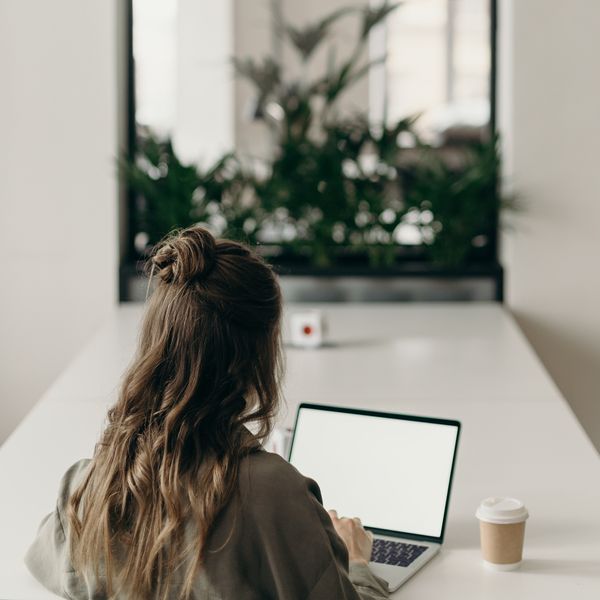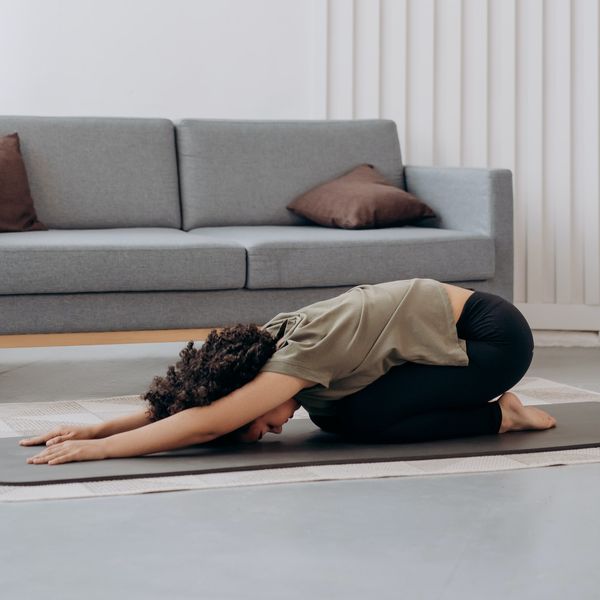Tech neck is no joke, y’all.
Here’s How An Expert Recommends Finding Desk-Induced Back Pain Relief At Home

Meredith Holser is B+C's resident affiliate writer. Meredith enjoys writing about a range of topics, but she's adopted e-commerce writing in all its many facets. Outside of work, you can catch Meredith hiking, trying new recipes, and dreaming about having a yummy little treat.
I used to think back pain was something that happened to other people, not me. That was before I was tied to my desk for a full-time position, though – doubts aside, I was quickly humbled by back pain in all sorts of places, plus a chronically stiff neck.
Though back pain relief is an ongoing journey for me, I know there are ways to alleviate the agony. I also know now that I’m not alone in my discomfort. According to Cross River Therapy, 8 out of 10 people in the United States experience back pain each year. If you’re one of them, this post is your path to healing (or at least, lessening) the aching, cramping, twitching, and shooting pain you might be dealing with.
Julia Rosenthal PT, DPT withEmpower Physical Therapyis a Board-Certified Orthopedic Clinical Specialist and Certified Pelvic Health Rehabilitation Specialist that knows a thing or two about work-related back pain. I spoke to her about why it happens in the first place, back pain relief exercises and stretches, plus even more tactics for feeling your best – physically *and* mentally – while on the clock.Why Your Back Pain Is Tied To Your Work

Photo by cottonbro studio / PEXELS
The most obvious culprit behind back pain is a less-than-optimized desk set-up, but according to Rosenthal, your pain can also be worsened by the demands of the work day. When we’re sitting in front of a computer for an extended amount of time, our bodies can be forced into poor postures and lack sufficient movement overall – plus, any mental stress we may endure during the week (83% of US workers suffer from work-related stress) can exacerbate any pain and/or muscle tension.
When we’re stressed out or anxious due to work, the Hypothalamic-Pituitary-Adrenal (or HPA) axis is activated, says Rosenthal. This leads to the release of stress hormones like cortisol.
High levels of cortisol have direct ties to general muscle tension, reduced blood flow that leads to stiffness, and inflammation that irritates tissues in the back. Further, cortisol and other stress response hormones can affect your pain perception, actually making you more sensitive to back discomfort. Depending on your situation, stress can also affect your normal sleep pattern, which triggers more physical issues. If you tend to shut down and become more sedentary when you’re stressed, that lack of activity will also contribute to increased back pain.
How To Get Back Pain Relief ASAP

Photo by Julia M Cameron / PEXELS
Ergonomics
Ergonomics, in a general sense, refers to your efficiency at work. In the context of work-related back pain, it’s concerned with a totally optimized and more importantly, comfortable workspace.
Rosenthal says that it’s crucial for in-office and remote workers alike to have a dedicated workspace with a good layout. Look for these things when you’re considering an ergonomic work set-up:
- Chairs should provide enough support to the spine without requiring you to lean back too much. The height of your chair should allow your feet to rest flat on the floor, with your hips slightly higher (or at the same level) as your knees.
- Desks should be set at a height that allows your elbows to rest at a 90 degree angle when typing or using the mouse.
- Monitors should be placed so that you’re looking at the screen on eye-level.
- Keyboards and mouses should be within easy, unstrained reach. You want your wrists to be in a neutral position.
- Lighting should be amply provided to avoid any eye strain.
- Clutter should be avoided entirely, especially if it forces you into uncomfortable positions.
Even if you’ve devoted a lot of care into designing your permanent workspace, having a few different places around the office or home where you can dial into different positions is great for back pain relief and prevention.
Changing your environment throughout the workday contributes to healthy postural variability.
“Postural variability means moving through and having access to different postures and positions. If you stay in the same position for too long, that position is bound to get uncomfortable,” Rosenthal tells me. “We want to give our joints the opportunity to move through the range they have available to them so that we continue being able to move through that range.”

Photo by Mikhail Nilov / PEXELS
Stretching
“Any [stretch] that promotes extension and rotation should feel great,” offers Rosenthal. Some examples of this include: a thoracic extension stretch, open book stretch, and a spinal twist stretch – these will get your back in an opposing position than what you’re used to during work. She offers even more for relieving tension:
Cat-Cow is a yoga-inspired stretch that targets the entire spine. To do it:
- Start on your hands and knees in a tabletop position.
- Inhale as you arch your back, lifting your head and tailbone up (Cow Pose).
- Exhale as you round your back, tucking your chin and tailbone (Cat Pose).
- Alternate between these two positions, flowing gently with your inhale and exhale.
Child's Pose, when combined with a side stretch, will help open up your back. To do it:
- Begin in a kneeling position.
- Sit back on your heels, reaching your arms forward on the floor (or to the top of your mat if you’re using a yoga mat).
- Lower your chest toward the ground while extending your arms.Hold this pose for a few deep breaths.
- Then, walk both of your hands to the right, feeling a gentle stretch along your left side. Hold this for a few breaths.
- Next, walk your hands to the left, feeling a stretch along your right side. Hold it for a few breaths.
Seated Forward Fold, when done with a rotation, provides postural variability. To do it:
- Sit on the floor with your legs extended straight. Inhale as you sit up tall.
- Exhale and fold forward from your hips, reaching your hands toward your feet.
- Hold this forward fold for a few breaths.
- Then, inhale as you sit up tall again.
- Exhale, twist your torso to the right, and reach your right hand toward your left foot. Inhale back to center.
- Exhale, twist your torso to the left, and reach your left hand toward your right foot. Repeat if you wish.
Seated Spinal Twist stretches out the spine. To do it:
- Sit with your legs extended straight.
- Bend one knee and cross it over your other leg, placing your foot flat on the floor.
- Inhale to sit up tall.
- Exhale, twist your torso to the opposite side of your bent knee.
- Hold the twist for a few breaths. Inhale back to center.
- Exhale, switch the position of your legs, and repeat the twist on the other side.
Sphinx Pose will further stretch your spine and provide variability. To do it:
- Lie on your stomach with your legs extended.
- Place your forearms on the ground, parallel to each other.
- Inhale as you lift your chest off the ground, keeping your hips down.
- Gently arch your back and look forward.

Photo by MART PRODUCTION / PEXELS
Exercising
Combining exercise – cardio and strength training – with stretching can help you alleviate back pain and also prevent it, according to Rosenthal.
“Making a plan for getting in enough strength training and cardiovascular exercise will also be important, since getting enough exercise can be hard when you're working from home,” she offers.
Strength training can increase muscle density and strength, improving your body’s resilience towards stress. It also leads to increased postural control, flexibility, and bone health. It's also quite good for your brain, too. Strength training releases endorphins, which are the body’s natural pain relievers and mood enhancers, which can positively target existing back pain.
Planks, bridges, deadlifts, and core exercises are all great movements to practice for back pain relief.
“If a person is already having back pain, training the core can even have pain relieving benefits,” says Rosenthal. “These muscles work together to create a pressure system that helps support the spine.”

Photo by Vlada Karpovich / PEXELS
Taking Breaks
Don’t hesitate to take breaks during the workday, too. They can not only help you improve your back pain relief, but breaks also provide much-needed pauses for your mind.
“Taking short breaks actually helps you stay focused, prevents burnout, and improves overall efficiency,” says Rosenthal. “There have actually been studies done on work productivity that show that people are more efficient and productive when they work in short bouts (25-45 minutes) followed by short breaks.”
Stepping away from the screen can minimize stress, one of the greatest factors contributing to back pain. Additionally, it can promote creativity and sustained focus when you do return to your desk. Rosenthal recommends using short breaks from work for a short walk outside or a stretching session.

Photo by Sam Lion / PEXELS
Socializing
When you have bigger breaks from work, such as evenings or weekends, making an effort to socialize can potentially be a *big* help with back pain relief. Engaging socially will diminish feelings of stress and anxiety which can contribute to muscle tension, central nervous system upregulation, and ultimately, back pain.
“People working at home may feel more isolated than people who are in an office and have more opportunity for interpersonal connection,” offers Rosenthal. “It's important for people to find ways to engage socially, whether that is making plans with their partners, friends, work colleagues or other out-of-work activities that they enjoy.”
Be your best self with more tips from Brit + Co.
Some quotes have been edited for clarity.
Lead photo by Karolina Grabowska / PEXELS.



















